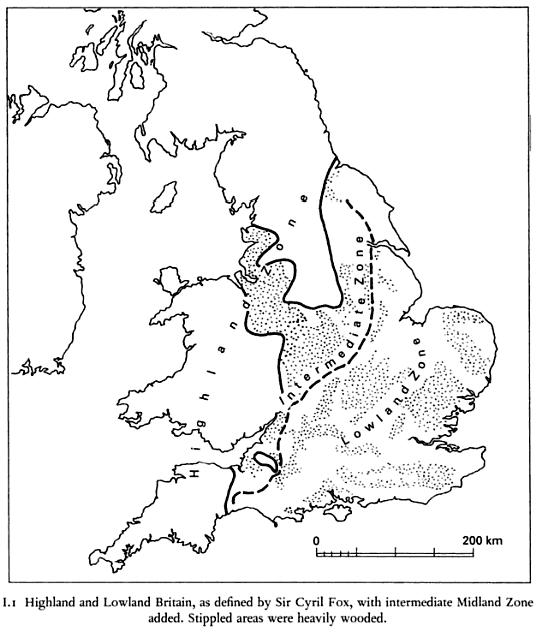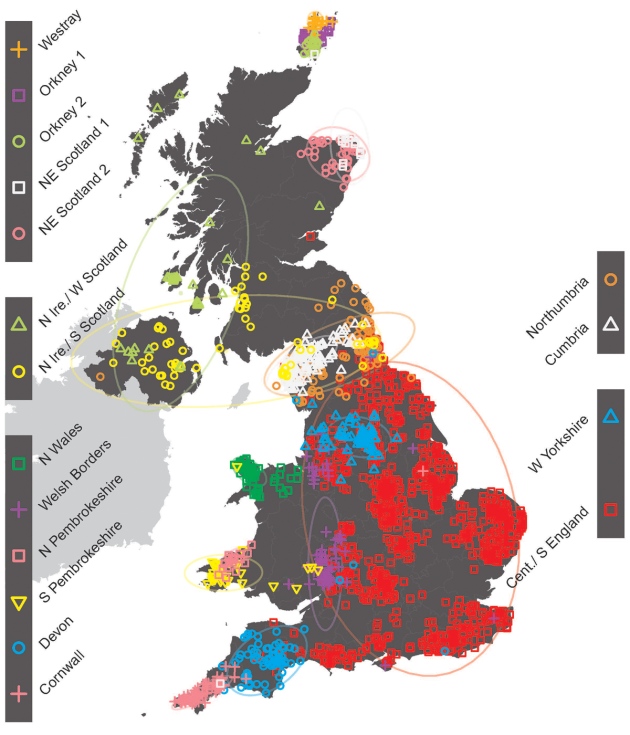from A Brief History of Great Britain (2010) [pages xiv-xvi]:
“Britain is marked by pronounced regional differences. The most basic division is that between highland areas and lowland areas. The ‘highland zone’ is defined by being over 200 meters (656 feet) above sea level. Highland zones are found in Wales, much of Scotland, northern England, and parts of southwestern England, although lowland pockets exist in highland territories. The British highland zone is not really mountainous, as the highest mountains reach the mode height of roughly 4000 feet (1,129 meters). There is a much higher proportion of highland land in Scotland than in England, and the difference between the highlands and the lowlands and their inhabitants plays a central role in Scottish history and culture.
“The highlands are marked by a greater emphasis on pastoralism, as they have mostly chalky soil and are too wet and cold for successful agriculture. The highlands are also much less densely populated than the lowlands, as it requires much more land to support a human being through pastoralism than through agriculture. Lowland areas are usually more fertile. The most fertile lowlands are in the south and southeast of Britain, where there is rich, heavy soil more suited to agriculture. Lowlanders can engage in raising either grains or livestock, depending on circumstances. In the Middle Ages much of the lowlands was truned over to the highly profitable production of wool. Lowlanders tended to live in villages, highlanders in small hamlets or isolated farmsteads, or to be nomadic.
“Invasions of Britain had much less effect on the highlands than on the lowlands, which constituted the really valuable prize due to their greater agricultural productivity. Those regimes exercising power throughout Britain or the British Isles were usually based in lowland England, the only place capable of supporting tehm. The extension of power from the lowlands to the highlands was a difficult challenge due to the difficulty of the terrain. Mountainous Wales preserved its independence for centuries despite its poverty and its inability to unite politically. The only invaders to subdue Wales before the 13th century were the well-organized and disciplined Roman legions, and it took them years after the conquest of England. The less-organized Anglo-Saxons, Vikings, and Normans had a much harder time, and Wales was only permanently annexed to England in 1284.
“The greater poverty of the highlands meant that highlanders often raided lowlanders, creating hostility between the two. The highlands were also more culturally and linguistically conservative. Cultural innovations usually originated in the lowlands and spread to the highlands. The highlands were where the Celtic languages lasted the longest, as English and its offshoots, originally the language of Anglo-Saxon invaders, became the dominant tongue of the lowlands in the early Middle Ages. This cultural division further added to the hostility between highland and lowland peoples.”
_____
from The Environment of Early Man in the British Isles (1975) [pgs. 147-149]:
“The Highland Zone/Lowland Zone division
“It is from this time [late bronze/early iron age] onwards that the division of the British Isles into Highland and Lowland Zones becomes relevant. The division has been used by geographers to explain differences in settlement patterns, farming practices and the quality of material culture between the two zones, and Cyril Fox exploited it to a considerable extent in ‘The Personality of Britain’.
“In brief, the Highland Zone (Fig. 62) is that part of the British Isles which is made up of the most ancient group of rocks, those formed in the Paleozoic Era. They lie in the north and west and the division with the later Mesozoic and Tertiary rocks of the Lowland Zone falls roughly on a line from the mouth of the Tees to the mouth of the Exe. The Palaeozoic rocks are generally hard, forming mountainous regions, with continuous streches over 300 metres above sea level. Plains and vales are not extensive. There are steep slopes and crags making cultivation difficult or impossible, and soils are often thin, stony and impoverished. Rainfall is high and there is a strong correspondence between the chief moorland areas and mean annual rainfall.
“Lowland Britain, on the other hand, is made up of geologically younger rocks which are softer, and which have given rise to a series of low-lying, rolling hills and intervening extensive vales and plains. Slopes are gentle, crags few and almost all the land is available for tillage, pasture or settlement. Soils are generally fertile and there is little evidence of erosion. Rainfall is light and there is little waste ground.
“But there are many topographical exceptions, in particular various lowland areas within the Highland Zone. Some of these are relatively small — the Vale of Glamorgan, the Hebridean machair and certain fertile river valleys such as Strath Tay. Others are of much greater extent, including the Central Scottish Lowlands, East Banff and Aberdeen, and the Orkney Islands. Ireland can be divided topographically into its own Highland and Lowland Zoens, and presents an anomaly in that approximately half the country is essentially lowland but situated in a high rainfall area….
“Indeed, the key distinction between the Highland and Lowland Zones is not so much elevation and topography as rainfall which is greatest in the west (Fig. 62) since this is the direction from which the main rain-bearing winds blow….

“[F]or a variety of economic and environmental reasons, the first millennium bc represents a period of significant change in the Highland Zone. Fields were abandoned and either reverted to pasture or waste ground, or became covered by peat. In low-lying areas communications became difficult because of mire formation or flooding. The importance of stone and Highland Zone metal deposits dwindled. And there was no great exploitation of timber for iron smelting as occurred in the Lowland Zone. Indeed, it is from the beginning of the Iron Age that the Highland Zone as a whole assumes the pastoral character which it has retained ever since.
“‘It is generally understood that…the remains of the monuments and material costructed or used throughout Britain reveal no noticeable differences in quality between the lowland and highland areas until well into the first millennium bc, but that thereafter a contrast developed between the two areas, comprising a falling-off of the material culture of the highland in comparison with that of the lowland — a contrast which has lasted to the present day.'”
_____
look! another line – the tees-exe line (the red one):

_____
from The British Isles: A History of Four Nations (1989, 2006) [pgs. 18-19]:
“To draw attention to this fact [i.e. that much of the pre-roman british isles was a part of a broader european celtic culture] is not to say that there was political and social uniformity throughout the area. The existence of tribal groupings in both Britain and Ireland is an indication of political differences at the local level. The Romans, to whom we are indebted for Latin versions of tribal names in the absence of their original Celtic forms, distinguished over twenty tribes in Britain south of the Forth. In Ireland, where politcal aggregation had not gone as far as it had elsewhere, the number of tribes seems to have been much larger.
“One powerful cause of variety was geography, in particular the contrast between Highland and Lowland Zones. It was Sir Cyril Fox who argued in his book ‘The Personality of Britain’ (1932) that the Lowlands would usually be exposed to forces of change before the Highlands. The Highland/Lowland contrast certainly makes good sense when applied to Britain, where north and west form a distinctive geographical area, including a good deal of land over 400 metres above sea-level. Poorer soil and climatic conditions made agriculture more of a challenge in the Highland Zone than it was in the south and east. In a British Isles context, however, the Highland/Lowland contrast is not quite so clear. Ireland, which has been compared to a saucer in which the rim represents the hills and the flat base the central plain, is not, geologically speaking, a Highland Zone. There is no doubt, however, that the narrow seas between north-west Ireland and south-west Scotland linked rather than divided them. At this particular period, however, it may be seen as forming part of a ‘cultural Highland Zone’, cut off, for better or worse, from the influence of the rising military power of Rome.
“Geographical determinism should not be pressed too far, however. It can also be argued that, under certain conditions, the Irish Sea provided a channel of communication…. It also seems to have been the case during the fifth and sixth centuries AD when Christian communities on both sides of the Irish Sea retained their links with Christian Europe at a time when the eastern half of Britain was being overrun by Germanic settlers. The Irish presence in Scotland in the sixth century AD and in parts of Wales illustrates the same point….
“Another contrast between the Highland and Lowland Zones was almost certainly demographic. No firm statistical evidence exists but several strong indicators suggest that there was a considerable increase of population in the Lowlands from the fifth century onwards, well before the Belgic invasions. A good deal of internal colonisation seems to have taken place during this period….”
_____
from The Culture of the English People: Iron Age to the Industrial Revolution (1994) [pgs. 5-7]:
“Some fifty years ago Sir Cyril Fox published one of the most seminal books in the history of British archaeology and culture, ‘The Personality of Britain’. In it he distinguished two parts of these islands, a ‘highland’ zone and a ‘lowland’ zone, with a boundary between them which ran from County Durham to Lyme Bay on the south coast (Fig. 1.1). This line separated a predominantly hilly region of Paleozoic rocks from a gentler region of Secondary and later rocks. These two regions, he argued, corresponded with two differing modes of cultural evolution. Simply expressed, his argument was that the bearers of outside cultural influences reached the Highland Zone often by sea and almost always in small numbers. Their impact was never sufficient to blanket or submerge the indigenous cultures. Instead they became assimilated. Elements of older cultures are today not only present, but conspicuously so in Highland Britain. Lowland Britain, by contrast, lay at the receiving end of a long series of invasions, from those who walked across the landbridge which once existed with Europe to the more recent invasions of Anglo-Saxons, Vikings and Normans. Each wave was powerful enough to impress its own culture, and thus to mask or to destroy pre-existing cultures. Fox commented on the relative ease with which new civilizations are established in the Lowland Zone, repressing without necessarily obliterating those which had prevailed before. ‘There is [thus] greater unity of culture in the Lowland Zone, but greater continuity in the Highland Zone.’
“The Fox model has not been without its critics. Some, including the present writer, would interpose a third zone covering the basically claylands of the English Midlands, between the Highland and the Lowland, with its own distinctive cultural history. But, however modified, the Fox model has been of incalculable imortance to a cultural history of these islands. It gives a rational explanation for a phenomenon which will recur in the pages of this book, namely the persistence of early cultural traits in the Celtic west and north, and the greater degree of cultural traits in the Celtic west and north, and the greater degree of cultural homogeneity in the lowlands of the south and east.”

_____
previously: this one’s for g.w. and the flatlanders vs. the mountain people
(note: comments do not require an email. lemur alert!)







